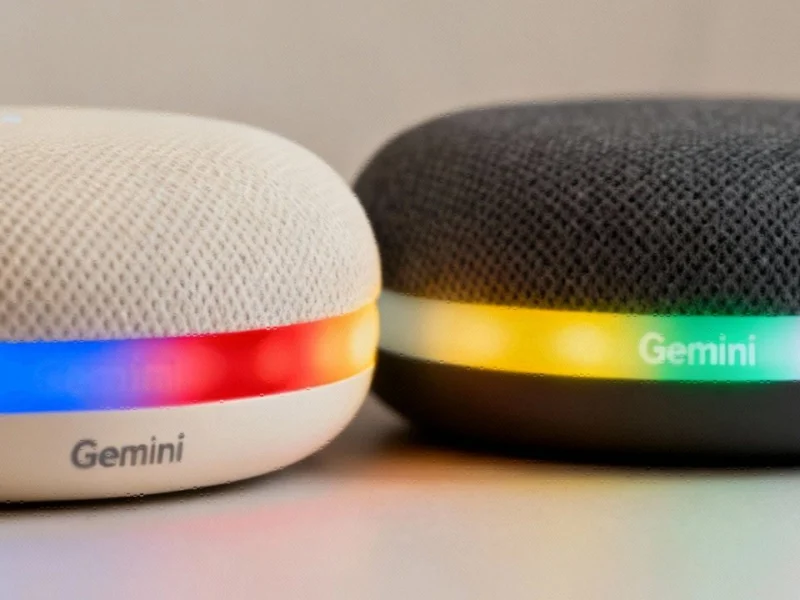Subtle Visual Changes Herald Major AI Integration
Google has initiated a quiet but significant transformation of its Nest speaker lineup, introducing a dynamic color display system that replaces the traditional white glow with a cycling spectrum of blue, red, yellow, and green. This visual overhaul, currently available to Preview Program users running firmware version 3.77.500695, represents more than just an aesthetic update—it signals Google’s strategic pivot toward deeper AI integration across its smart home ecosystem.
The new color scheme directly mirrors Gemini’s branding, suggesting that Nest hardware is becoming increasingly intertwined with Google’s expanding artificial intelligence framework. As industry developments in AI continue to accelerate, this visual transformation serves as a tangible indicator of the underlying technological shifts occurring within Google’s product ecosystem.
User Experience Transformation Beyond Visual Changes
Early adopters on platforms like Reddit have reported noticeable alterations in voice response patterns, device pairing behavior, and speaker interactions. These functional changes, documented by technology analysts, indicate that Gemini’s influence extends far beyond cosmetic adjustments. The color cycling effect appears most pronounced on Chalk and Charcoal Nest models, creating a visually striking experience that distinguishes the updated devices from their predecessors.
Google’s approach reflects a broader trend in recent technology deployments, where visual cues are used to acclimate users to underlying platform changes. This strategy allows for smoother transitions when more substantial functional updates are introduced later. The timing of this rollout is particularly significant, arriving just weeks before Gemini’s anticipated public debut on Home devices scheduled for October 28 in the U.S. market.
Strategic Positioning in the Evolving Smart Home Landscape
This transition positions Nest devices as active AI companions rather than passive audio equipment. The color changes serve as the first layer in what appears to be a comprehensive overhaul of how Nest products interact with users and integrate into daily routines. As global technology refresh cycles influence consumer electronics across categories, Google’s methodical approach to Nest evolution demonstrates careful planning in an increasingly competitive market.
The gradual implementation strategy acknowledges the complexity of migrating from Google Assistant to Gemini while maintaining user familiarity. Not all users will receive the update simultaneously, allowing Google to monitor performance and user feedback before broader deployment. This measured rollout mirrors approaches seen in other sectors, including the organizational restructuring strategies employed by major institutions facing technological transformation.
Broader Implications for Smart Device Evolution
Google’s visual and functional updates to Nest speakers represent a microcosm of larger trends affecting connected devices worldwide. As artificial intelligence becomes increasingly embedded in consumer products, manufacturers are exploring new ways to communicate device status, processing activity, and AI engagement through visual indicators. These developments occur alongside other significant market trends, including increased attention to how technology impacts various sectors.
The Nest speaker updates also arrive during a period of heightened scrutiny regarding AI implementation across industries. As concerns emerge about how AI-generated content might affect various fields, Google’s transparent visual approach to AI integration through color changes represents an interesting counterpoint—making the technology’s presence more explicit rather than hidden from users.
Future Outlook and Industry Impact
Looking ahead, the Nest speaker color changes likely preview a series of forthcoming enhancements that will further blur the lines between hardware functionality and AI personality. As Gemini becomes more deeply embedded in Google’s product ecosystem, users can expect additional updates that refine how smart devices understand context, anticipate needs, and integrate into daily routines.
These developments reflect broader movements in related innovations across the technology sector, where visual design increasingly serves as both functional interface and brand communication. For Google, the colorful new lights on Nest speakers represent both an immediate refresh to existing products and a strategic positioning for the company’s AI-driven future—one where smart devices become increasingly personalized, responsive, and integrated into the fabric of everyday life.
This article aggregates information from publicly available sources. All trademarks and copyrights belong to their respective owners.



